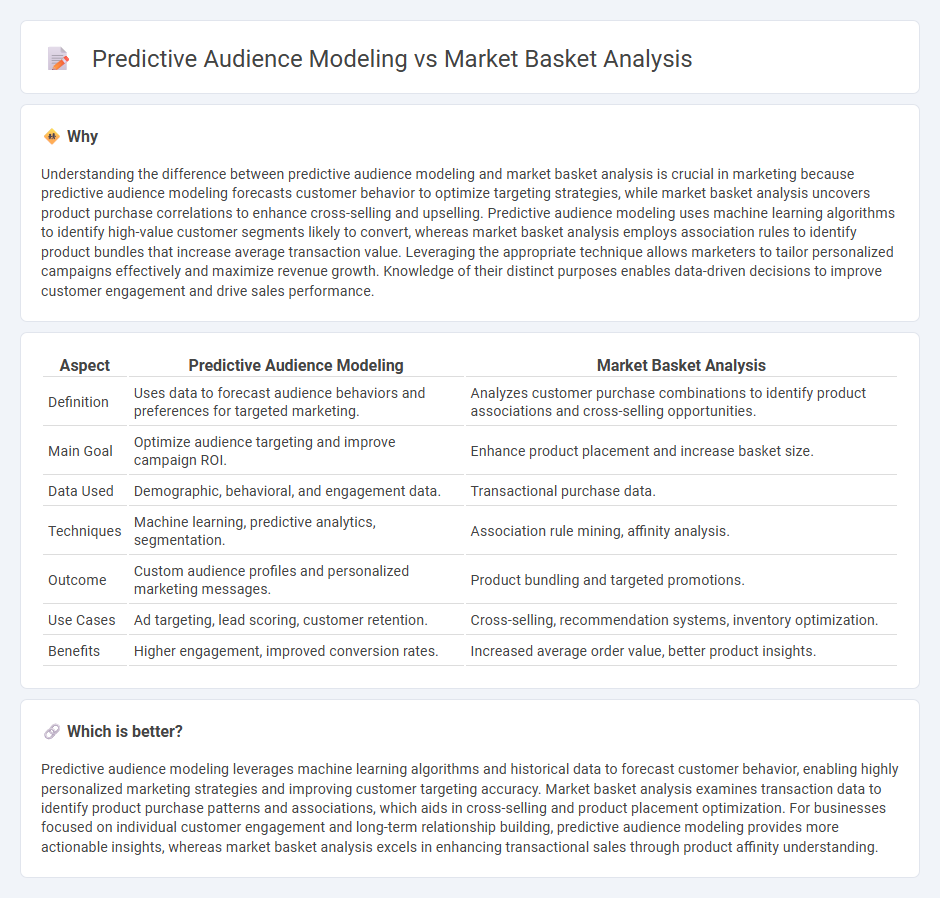
Predictive audience modeling leverages machine learning algorithms to forecast consumer behavior and target potential customers with personalized marketing strategies, enhancing campaign efficiency and ROI. Market basket analysis examines transaction data to identify product associations and purchasing patterns, enabling marketers to optimize cross-selling and promotional tactics. Discover how these powerful marketing tools can transform your approach to customer engagement and sales growth.
Why it is important
Understanding the difference between predictive audience modeling and market basket analysis is crucial in marketing because predictive audience modeling forecasts customer behavior to optimize targeting strategies, while market basket analysis uncovers product purchase correlations to enhance cross-selling and upselling. Predictive audience modeling uses machine learning algorithms to identify high-value customer segments likely to convert, whereas market basket analysis employs association rules to identify product bundles that increase average transaction value. Leveraging the appropriate technique allows marketers to tailor personalized campaigns effectively and maximize revenue growth. Knowledge of their distinct purposes enables data-driven decisions to improve customer engagement and drive sales performance.
Comparison Table
| Aspect | Predictive Audience Modeling | Market Basket Analysis |
|---|---|---|
| Definition | Uses data to forecast audience behaviors and preferences for targeted marketing. | Analyzes customer purchase combinations to identify product associations and cross-selling opportunities. |
| Main Goal | Optimize audience targeting and improve campaign ROI. | Enhance product placement and increase basket size. |
| Data Used | Demographic, behavioral, and engagement data. | Transactional purchase data. |
| Techniques | Machine learning, predictive analytics, segmentation. | Association rule mining, affinity analysis. |
| Outcome | Custom audience profiles and personalized marketing messages. | Product bundling and targeted promotions. |
| Use Cases | Ad targeting, lead scoring, customer retention. | Cross-selling, recommendation systems, inventory optimization. |
| Benefits | Higher engagement, improved conversion rates. | Increased average order value, better product insights. |
Which is better?
Predictive audience modeling leverages machine learning algorithms and historical data to forecast customer behavior, enabling highly personalized marketing strategies and improving customer targeting accuracy. Market basket analysis examines transaction data to identify product purchase patterns and associations, which aids in cross-selling and product placement optimization. For businesses focused on individual customer engagement and long-term relationship building, predictive audience modeling provides more actionable insights, whereas market basket analysis excels in enhancing transactional sales through product affinity understanding.
Connection
Predictive audience modeling leverages customer data to forecast future behaviors, while market basket analysis identifies product associations within transactions. Together, these techniques enable marketers to anticipate customer needs by understanding purchasing patterns and segmenting audiences effectively. This integration drives targeted campaigns that enhance cross-selling opportunities and improve ROI.
Key Terms
**Market Basket Analysis:**
Market Basket Analysis identifies product purchase patterns by examining transaction data to reveal co-occurring items frequently bought together, which helps businesses optimize product placement and cross-selling strategies. This method leverages association rules and support-confidence metrics to uncover hidden relationships between products, boosting sales and customer satisfaction. Explore how Market Basket Analysis can transform your retail strategy with data-driven insights.
Association Rules
Market basket analysis utilizes association rules to identify patterns and relationships between products frequently purchased together, enhancing cross-selling strategies and inventory management. Predictive audience modeling leverages association rules to forecast future consumer behavior and preferences by analyzing previous purchase combinations and browsing data. Explore deeper insights into how association rules power these distinct approaches for optimized marketing strategies.
Support
Market basket analysis leverages association rules mining to identify product purchase patterns and frequently co-occurring items, focusing on transactional support to measure the strength of these itemsets. Predictive audience modeling employs machine learning algorithms to forecast consumer behavior and segment audiences based on demographic and behavioral data, emphasizing support in terms of sample size and data representation for model reliability. Explore detailed comparisons and applications in retail analytics to enhance customer targeting strategies.
Source and External Links
Market Basket Analysis in Data Mining - GeeksforGeeks - Market Basket Analysis is a data mining technique used in retail and e-commerce to identify products frequently bought together, helping businesses improve inventory management, pricing, and store layout for increased sales.
Understanding Market Basket Analysis in Data Mining - Turing - This analysis uncovers patterns of co-occurrence in customer purchases, enabling retailers to place related items together or offer targeted discounts, ultimately driving cross-selling and revenue growth.
Market Basket Analysis 101: Anticipating Customer Behavior - By revealing which products are often purchased in combination, Market Basket Analysis helps retailers design effective cross-selling strategies, product recommendations, and personalized marketing campaigns.
 dowidth.com
dowidth.com